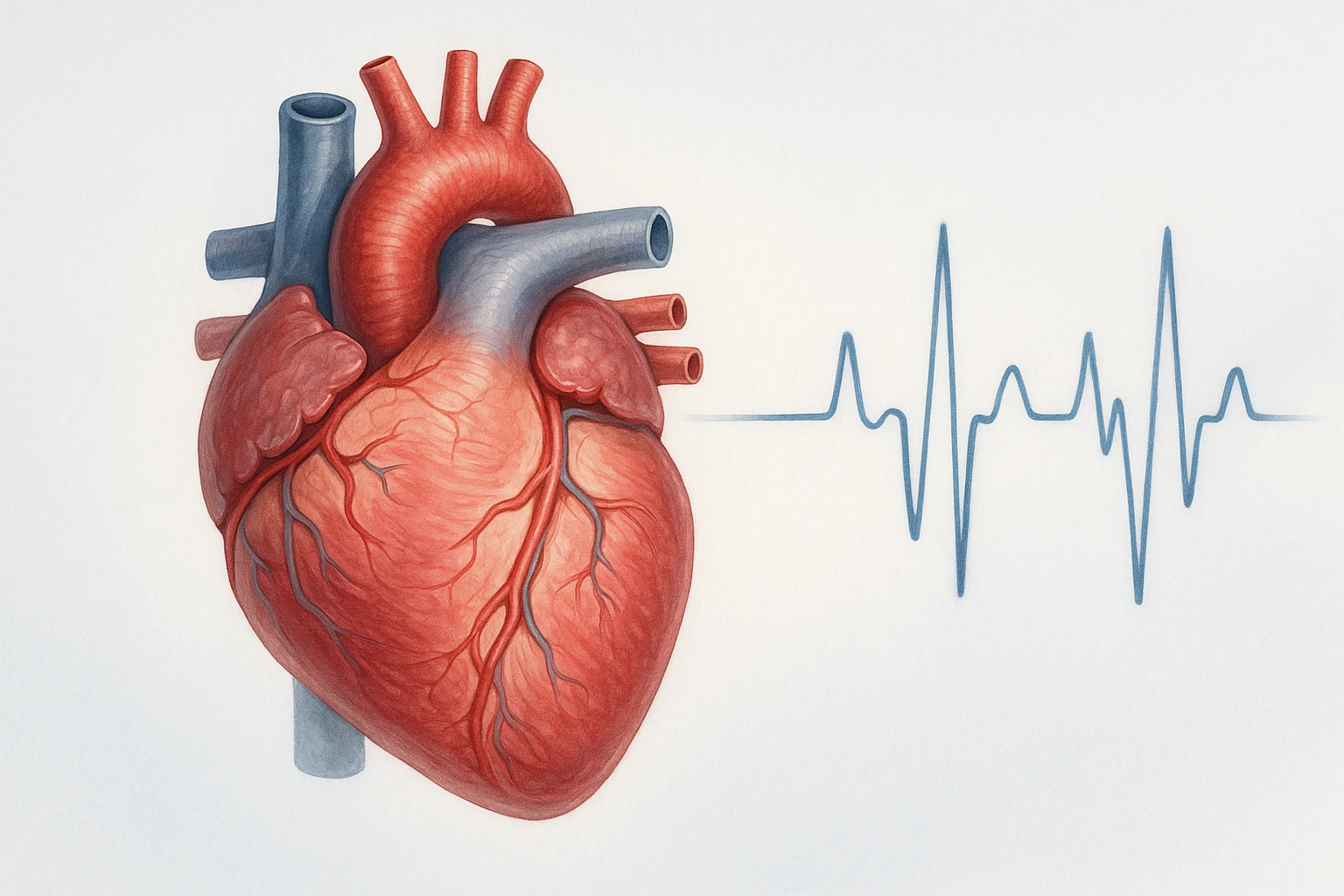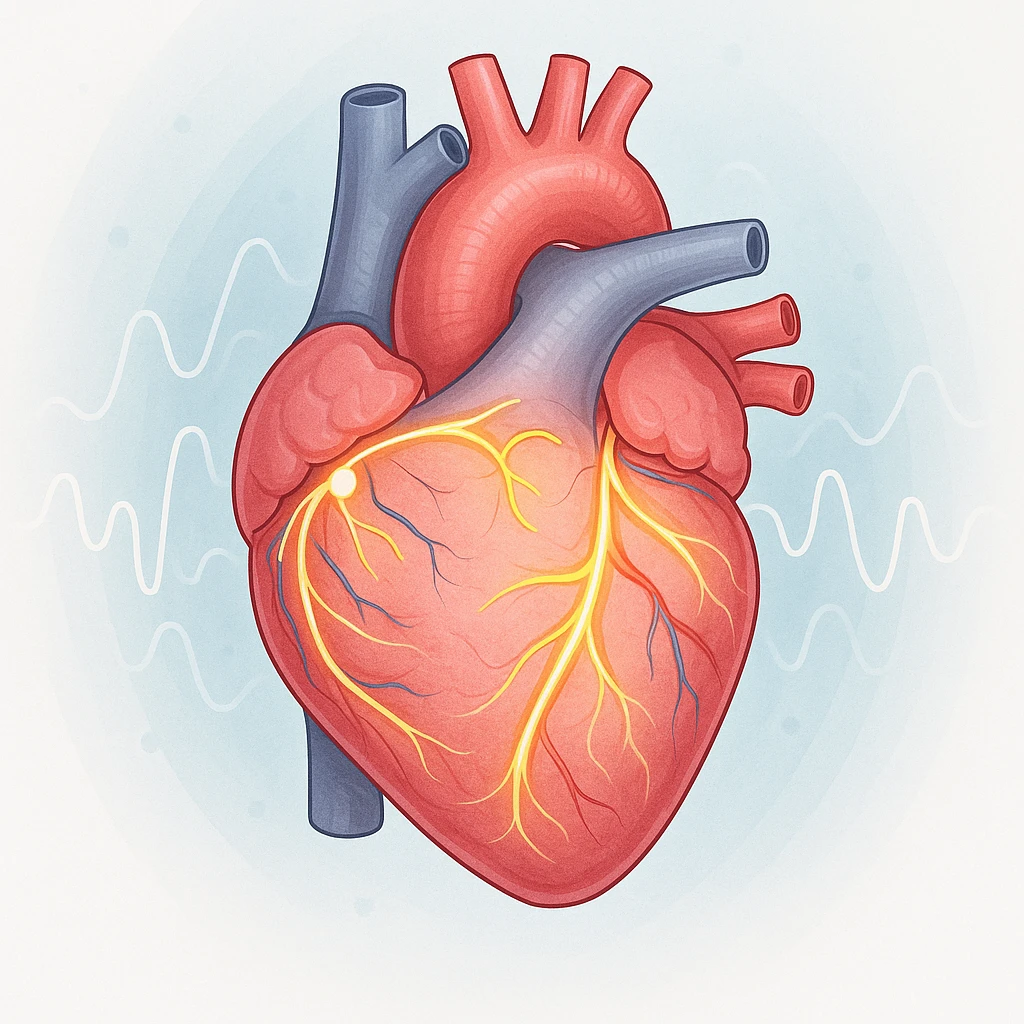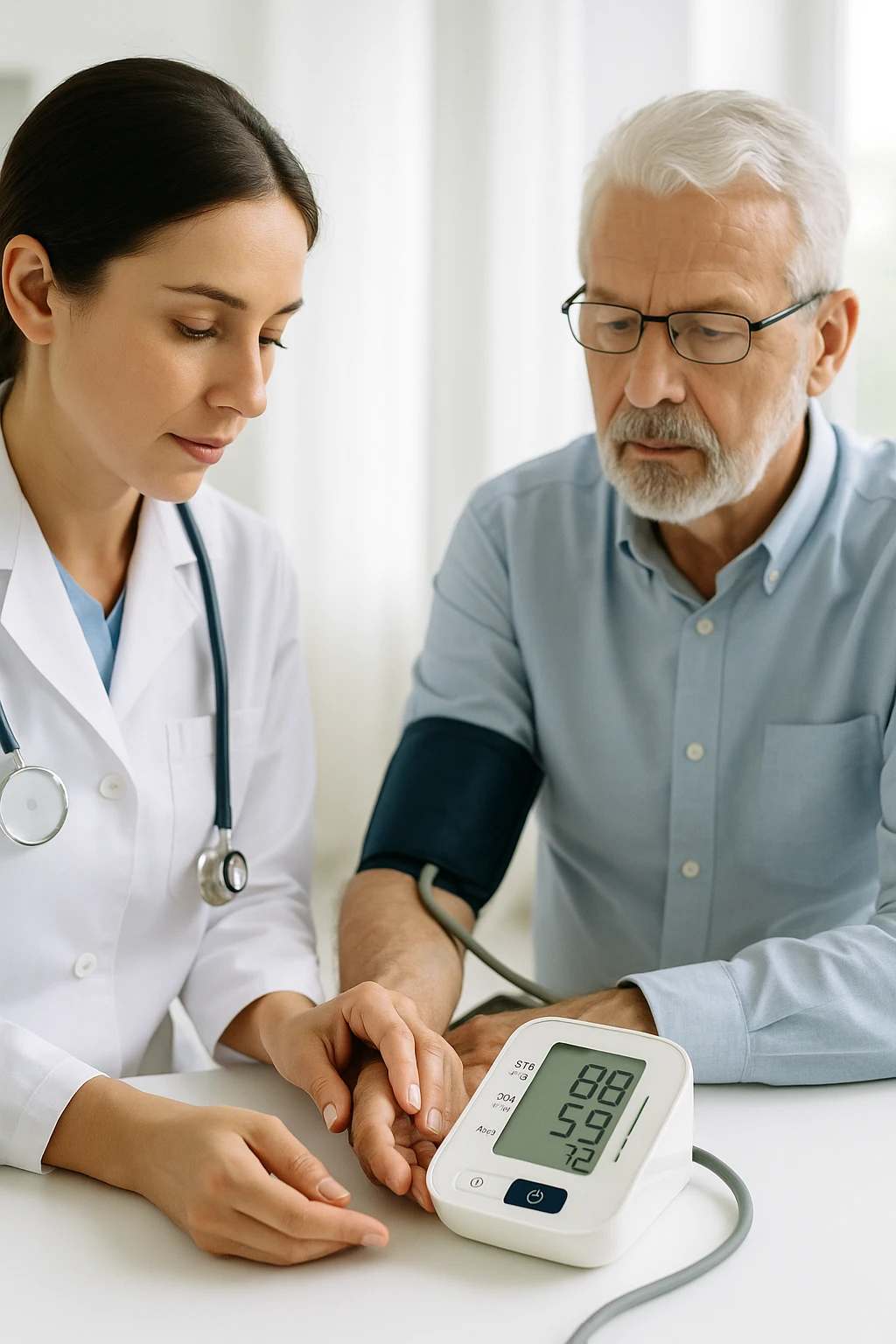Palpitations After Meals: Common Triggers and How to Manage Them
Postprandial Palpitations: Definition and Clinical Significance
What Are Postprandial Palpitations?
Postprandial palpitations describe the awareness of a rapid, fluttering, or pounding heartbeat occurring shortly after eating. This temporal link between food intake and symptom onset distinguishes them from other rhythm disturbances unrelated to digestion. In many individuals, these sensations reflect normal physiologic adjustments as the cardiovascular system adapts to increased metabolic demand and redistribution of blood flow during digestion. However, in some cases, they may signal an underlying rhythm disturbance or an exaggerated autonomic response.
Not all meal-related palpitations indicate cardiac disease. Many occur in healthy individuals without structural heart abnormalities. These transient rhythm changes are often benign responses to digestion, though persistent or severe symptoms warrant medical evaluation to rule out arrhythmic disorders or other conditions.
Symptom Presentation
Patients commonly describe palpitations after eating as sudden awareness of their heartbeat-felt as skipping, fluttering, or pounding sensations in the chest or throat. Episodes usually begin within minutes of finishing a meal and last seconds to several minutes. The reproducibility and timing of symptoms relative to food intake provide valuable diagnostic clues for clinicians.
- Palpitations may feel like skipped beats, fluttering, or pounding sensations.
- They typically appear within minutes of completing a meal and resolve quickly.
- Larger or carbohydrate-heavy meals more frequently provoke symptoms.
- Some individuals report mild dizziness or warmth as blood flow shifts toward digestion.
Recognizing these symptom patterns helps differentiate benign postprandial palpitations from rhythm disorders requiring clinical attention.
When Palpitations Become Concerning
Although most postprandial palpitations are harmless, certain features warrant immediate medical evaluation. Palpitations associated with chest pain, shortness of breath, or fainting (syncope) may reflect a serious cardiac condition such as arrhythmia or ischemia. Identifying these red-flag symptoms supports early diagnosis and intervention.
- Chest pain or pressure with palpitations
- Shortness of breath or difficulty breathing
- Lightheadedness, dizziness, or fainting
Awareness of warning signs enables timely management and helps prevent complications in individuals with underlying cardiovascular disease.
Physiologic Mechanisms Behind Palpitations After Eating
Hemodynamic Adjustments After Eating
After a meal, the body undergoes coordinated cardiovascular adjustments to facilitate digestion. Blood flow is redirected to the gastrointestinal tract-a process called splanchnic vasodilation. Cardiac output increases by approximately 18%, while total peripheral resistance decreases by about 17%. These shifts ensure adequate organ perfusion but may temporarily alter heart rhythm, producing sensations of palpitations.
- Cardiac output rises by roughly 18% post-meal to meet metabolic demand.
- Total peripheral resistance decreases by around 17% due to vasodilation.
- The heart compensates with mild tachycardia to maintain perfusion.
In predisposed individuals-such as those with autonomic imbalance or reduced cardiac reserve-this compensatory heart rate rise may be felt as distressing palpitations, often peaking within 15-30 minutes after eating.
Autonomic Nervous System Dynamics
The autonomic nervous system (ANS) modulates heart rate and vascular tone during digestion. Initially, parasympathetic activity promotes gastric motility, while sympathetic activation later balances blood pressure and cardiac output. In some individuals, an exaggerated sympathetic response triggers transient tachycardia, perceived as a fluttering or racing heartbeat.
These normal physiologic responses can feel abnormal in those with heightened cardiac awareness, illustrating how autonomic regulation contributes to post-meal palpitations.
Gastrocardiac Interactions
Mechanical and reflex pathways also influence palpitations after eating. Gastric distension-especially after large meals-can stimulate vagal afferents affecting cardiac rhythm. This vagovagal reflex may produce skipped or irregular beats.
In conditions such as hiatal hernia, mechanical proximity between the stomach and heart may further provoke rhythm changes-a phenomenon known as gastrocardiac (Roemheld) syndrome. While uncommon, these interactions highlight the complex interplay between digestive and cardiac systems.
Dietary and Lifestyle Triggers of Palpitations After Eating
Common Nutritional Triggers
Several dietary elements can provoke palpitations after eating. Meals high in carbohydrates or sugars may cause rapid shifts in blood glucose and insulin, altering autonomic tone and heart rate. High-sodium foods increase intravascular volume and cardiac workload, making the heartbeat more noticeable. Common triggers include processed snacks, fast foods, and other salty items.
- High-carbohydrate or sugary foods can rapidly affect heart rate.
- Excess sodium raises cardiac workload and sensitivity.
- Processed and fast foods frequently provoke symptoms.
Specific components such as monosodium glutamate (MSG), tyramine (in aged cheeses and cured meats), and theobromine (in chocolate) may also alter catecholamine activity, occasionally triggering palpitations in susceptible individuals. These effects are generally benign but can be distressing when recurrent.
Meal Size and Composition
The size and nutrient balance of meals influence postprandial cardiovascular responses. Large meals increase splanchnic blood flow demand, leading to compensatory rises in heart rate. In contrast, smaller, balanced meals minimize abrupt circulatory shifts and help prevent palpitations.
| Meal Characteristic | Effect on Heart Rate |
|---|---|
| Large portions | Increase gastrointestinal blood flow and trigger compensatory tachycardia |
| High refined carbohydrates | Cause rapid glycemic and hormonal fluctuations |
| Balanced macronutrients | Promote stable circulation and heart rhythm |
Lifestyle Contributors
Beyond diet, lifestyle factors significantly impact postprandial palpitations. Caffeine and alcohol act as cardiac stimulants, increasing heart rate and contractility. Dehydration reduces circulating volume, amplifying cardiovascular responses after meals. Emotional stress, anxiety, and inadequate rest heighten autonomic sensitivity, increasing perception of palpitations.
- Caffeine and alcohol stimulate the heart and intensify symptoms.
- Dehydration and stress elevate cardiovascular responsiveness.
- Rest and balanced routines support autonomic stability.
Myths vs Facts
- Myth: All palpitations after eating indicate heart disease.
- Fact: Many are benign physiologic responses to digestion.
- Myth: Only caffeine causes post-meal palpitations.
- Fact: Large or high-sodium meals can also trigger normal circulatory changes.
Clinical Associations and Diagnostic Evaluation
Associated Medical Conditions
Palpitations after eating may occur without structural heart disease but can also accompany conditions affecting both cardiac and gastrointestinal systems. Case reports link them to hiatal hernia and gastroesophageal reflux disease (GERD), where gastric distension or vagal stimulation influences heart rhythm. Other contributors include pre-existing arrhythmias, thyroid dysfunction, anemia, and metabolic disorders, which heighten cardiovascular responsiveness.
- Hiatal hernia and GERD may provoke vagal cardiac responses.
- Thyroid or metabolic disorders amplify cardiac reactivity.
- Existing arrhythmias can worsen postprandial symptoms.
Diagnostic Work-Up
Evaluation starts with detailed history and physical examination, focusing on symptom timing, diet, medications, and associated complaints such as dizziness or breathlessness. Identifying reproducible triggers helps differentiate physiologic from pathologic causes.
| Diagnostic Tool | Purpose |
|---|---|
| ECG | Detects rhythm abnormalities at rest or during episodes |
| Holter or Event Monitor | Captures transient arrhythmias correlated with meals |
| Echocardiography | Evaluates structural or functional cardiac abnormalities |
Recognizing Red Flags
Although most meal-related palpitations are benign, symptoms accompanied by chest pain, shortness of breath, or syncope warrant urgent evaluation. Persistent or worsening episodes in individuals with cardiovascular risk factors may indicate structural heart disease requiring treatment.
- Chest pain or pressure during or after eating
- Shortness of breath or lightheadedness with palpitations
- Fainting or near-syncope after meals
When to See a Doctor
- Seek immediate care if symptoms occur with chest pain, shortness of breath, or fainting.
- Consult a clinician for recurrent or prolonged palpitations after meals.
- Report changes in diet, medication, or new gastrointestinal or cardiac symptoms.
Management, Prevention, and Patient Education for Palpitations After Eating
Lifestyle and Dietary Adjustments
Management of palpitations after eating primarily involves modifying dietary habits and daily routines to reduce symptom frequency. The cornerstone of prevention includes eating smaller, more frequent meals that minimize abrupt cardiovascular and autonomic shifts caused by large portions. Avoiding dietary triggers such as high-glycemic foods, excessive salt, caffeine, and alcohol can help stabilize post-meal heart rate and circulation. Balanced meals containing complex carbohydrates, lean proteins, and fiber support gradual nutrient absorption and reduce sudden cardiovascular load.
- Eat smaller, more frequent meals to avoid abrupt circulatory changes.
- Limit high-glycemic, high-salt, and stimulant-containing foods.
- Maintain good hydration to reduce compensatory heart rate elevation.
- Manage gastrointestinal conditions such as GERD or hiatal hernia that may worsen palpitations.
Maintaining adequate hydration is crucial, as dehydration can heighten compensatory cardiovascular responses after eating. In patients with coexisting gastroesophageal reflux disease or hiatal hernia, managing these conditions may help alleviate postprandial palpitations since mechanical and vagal influences can exacerbate symptoms following meals.
Medical and Follow-Up Care
While lifestyle modification controls most cases of palpitations after eating, persistent or severe episodes may require medical evaluation. A cardiology or gastroenterology referral can be beneficial when diagnostic testing reveals an arrhythmia, structural heart abnormality, or gastrointestinal contributor. In select patients, pharmacologic interventions-such as rate-controlling or antiarrhythmic therapy-may be appropriate under specialist supervision, especially when symptoms affect quality of life or indicate underlying disease.
| Care Component | Purpose |
|---|---|
| Cardiology or Gastroenterology Referral | Identifies cardiac or gastrointestinal causes contributing to palpitations. |
| Pharmacologic Therapy | Used selectively to control heart rate or rhythm abnormalities. |
| Regular Follow-Up | Monitors treatment effectiveness and detects new or worsening conditions early. |
Routine follow-up ensures ongoing effectiveness of therapeutic strategies and prompt evaluation of new symptoms. Continuous or periodic monitoring is often recommended for patients with comorbidities or a history of cardiac disease, as they may be at higher risk for complications.
Patient Education and Monitoring
Patient education and proactive monitoring play central roles in long-term management. Keeping a detailed symptom diary-recording meal content, timing, and sensations-can help identify specific triggers and inform dietary adjustments. Recognizing symptom patterns allows patients and clinicians to distinguish benign, lifestyle-related palpitations from those warranting further investigation.
- Track meals, timing, and symptoms to identify individual triggers.
- Discuss patterns and concerns with healthcare professionals.
- Seek medical attention if chest pain, shortness of breath, or fainting occurs.
Education should also reinforce recognition of red-flag symptoms-chest pain, dyspnea, or syncope-that require urgent medical evaluation. With proper lifestyle management, ongoing communication with healthcare providers, and early response to warning signs, most individuals can successfully manage postprandial palpitations and maintain good cardiovascular health.
Frequently Asked Questions About Palpitations After Eating
- Why do heart palpitations sometimes happen after eating?
- Palpitations after eating often result from the body redirecting blood to the digestive organs, which can temporarily increase heart rate and rhythm awareness. This is a normal physiologic response for most people.
- Are palpitations after meals always a sign of heart disease?
- No, many cases are benign and related to digestion, meal size, or certain foods. However, persistent or severe symptoms should be checked by a clinician to rule out heart rhythm problems.
- Which foods are most likely to trigger palpitations after eating?
- Large meals, high-carbohydrate dishes, and foods high in salt, sugar, or additives like MSG and tyramine are common triggers. Alcohol, caffeine, and rich or fatty foods can also contribute.
- How long do post-meal palpitations usually last?
- They typically begin within minutes of finishing a meal and last a few seconds to several minutes. The duration often depends on meal size and individual sensitivity.
- Can stress or dehydration make palpitations worse?
- Yes, emotional stress and low hydration increase autonomic activity and cardiovascular strain, making palpitations more noticeable after meals.
- When should I worry about palpitations after eating?
- Seek urgent care if palpitations occur with chest pain, shortness of breath, dizziness, or fainting. These can indicate more serious cardiac or circulatory problems.
- How are meal-related palpitations diagnosed?
- Doctors may perform an ECG, echocardiogram, or rhythm monitoring to check for arrhythmias. They will also assess diet, medications, and medical history to identify triggers.
- Can lifestyle changes reduce palpitations after eating?
- Yes, eating smaller, balanced meals and avoiding excessive salt, sugar, caffeine, and alcohol often helps. Managing reflux, stress, and hydration can also lessen symptoms.
- Are conditions like GERD or hiatal hernia linked to post-meal palpitations?
- They can be. In these conditions, stomach distension or pressure may affect nearby cardiac nerves, occasionally triggering rhythm changes known as gastrocardiac interactions.
- What should I tell my doctor about my palpitations?
- Keep track of when symptoms occur, what you ate, and any accompanying sensations. Sharing this pattern helps your healthcare provider identify causes and plan appropriate care.













